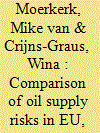|
|
|
Sort Order |
|
|
|
Items / Page
|
|
|
|
|
|
|
| Srl | Item |
| 1 |
ID:
150377


|
|
|
|
|
| Summary/Abstract |
For many countries, the inflow of energy is essential to keep economies running. Oil is typically considered to be the most critical fuel as an input for the petro-chemical and transportation sector and due to limited and less spread reserves. In this study external oil supply risks are assessed for the period up to 2035 for the European Union, United States, China, Japan and India (being the five largest importers of oil in the world), based on their current supplier portfolio. Scenarios are constructed for several climate policy and oil-supply projections.
It is found that risks increase strongly, when stringent climate policies are prevented from being implemented, especially when a peak in oil supply is taken into account, resulting in major oil supply-disruptions. China faces the lowest oil supply risks in most scenarios but the trends of India, China and US converge over time due to increasing import dependency of China and India. Japan faces high risks since the country has the highest oil import dependency combined with a low oil import diversification. For the EU, all figures are strongly influenced by Russia, accounting for 32% of total imports, and to a lesser extent Norway (11%), with high overall risks.
|
|
|
|
|
|
|
|
|
|
|
|
|
|
|
|
| 2 |
ID:
127912


|
|
|
|
|
| Publication |
2014.
|
| Summary/Abstract |
Ireland imports 88% of its energy requirements. Oil makes up 59% of total final energy consumption (TFC). Import dependency, low fuel diversity and volatile prices leave Ireland vulnerable in terms of energy security. This work models energy security scenarios for Ireland using long term macroeconomic forecasts to 2050, with oil production and price scenarios from the International Monetary Fund, within the Irish TIMES energy systems model. The analysis focuses on developing a least cost optimum energy system for Ireland under scenarios of constrained oil supply (0.8% annual import growth, and -2% annual import decline) and subsequent sustained long term price shocks to oil and gas imports. The results point to gas becoming the dominant fuel source for Ireland, at 54% total final energy consumption in 2020, supplanting oil from reference projections of 57% to 10.8% TFC. In 2012, the cost of net oil imports stood at €3.6 billion (2.26% GDP). The modelled high oil and gas price scenarios show an additional annual cost in comparison to a reference of between €2.9bn and €7.5bn by 2020 (1.9-4.9% of GDP) to choose to develop a least cost energy system. Investment and ramifications for energy security are discussed.
|
|
|
|
|
|
|
|
|
|
|
|
|
|
|
|
|
|
|
|
|